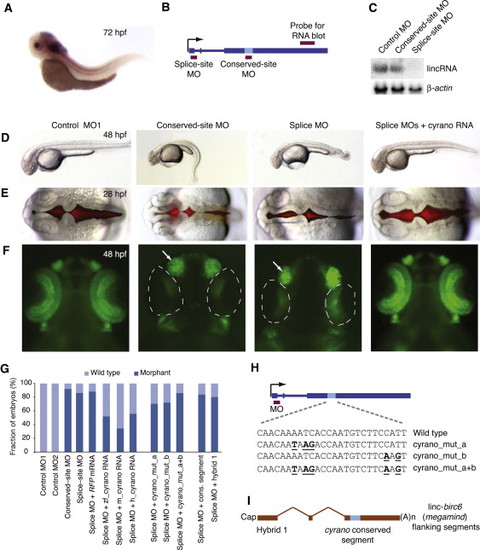Fig. 5
- ID
- ZDB-FIG-120202-5
- Publication
- Ulitsky et al., 2011 - Conserved Function of lincRNAs in Vertebrate Embryonic Development despite Rapid Sequence Evolution
- Other Figures
- All Figure Page
- Back to All Figure Page
|
The Importance of linc-oip5 for Proper Embryonic Development (A) In situ hybridization showing cyrano expression in the CNS and notochord of zebrafish embryos at 72 hpf. (B) Gene architecture of cyrano, showing the hybridization sites of the RNA-blot probe and MOs (red boxes). (C) RNA blot monitoring cyrano accumulation in wild-type embryos (48 hpf) that had been injected with the indicated MOs. To control for loading, the blot was reprobed for β-actin mRNA. (D) Embryos at 48 hpf that had been either injected with the indicated MO or coinjected with the splice-site MO and mature mouse cyrano RNA. (E) Brain ventricles after injection with the indicated reagents, visualized using a red fluorescent dye injected into the ventricle space at 28 hpf. (F) Embryos at 48 hpf that had been injected with the indicated reagents. NeuroD-positive neurons in the retina and nasal placode were marked with GFP expressed from the neurod promoter (Obholzer et al., 2008). Near absence of NeuroD-positive neurons in the retina (dotted line) and enlargement of the nasal placode (arrow) are indicated.n (G) Frequency of morphant phenotypes in injected embryos (Table S5). (H) Schematic of DNA point substitutions in the cyrano-conserved site. (I) Architecture of a hybrid transcript containing the cyrano-conserved segment in the context of linc-birc6 (megamind)-flanking sequences. See also Figure S4 and Table S5. |
| Genes: | |
|---|---|
| Fish: | |
| Knockdown Reagents: | |
| Anatomical Terms: | |
| Stage Range: | Long-pec to Protruding-mouth |
| Fish: | |
|---|---|
| Knockdown Reagents: | |
| Observed In: | |
| Stage: | Long-pec |
Reprinted from Cell, 147(7), Ulitsky, I., Shkumatava, A., Jan, C.H., Sive, H., and Bartel, D.P., Conserved Function of lincRNAs in Vertebrate Embryonic Development despite Rapid Sequence Evolution, 1537-1550, Copyright (2011) with permission from Elsevier. Full text @ Cell

